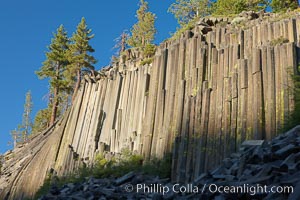
Devil's Postpile, a spectacular example of columnar basalt. Once molten and under great pressure underground, the lava that makes up Devil's Postpile cooled evenly and slowly, contracting and fracturing into polygonal-sided columns. The age of the formation is estimated between 100 and 700 thousand years old. Sometime after the basalt columns formed, a glacier passed over the formation, cutting and polishing the tops of the columns. The columns have from three to seven sides, varying because of differences in how quickly portions of the lava cooled.
Location: Devils Postpile National Monument, California
Image ID: 23266
Location: Devils Postpile National Monument, California
Image ID: 23266
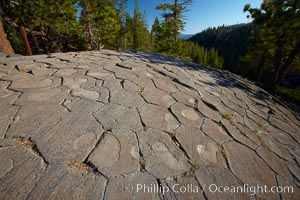
Devil's Postpile, a spectacular example of columnar basalt. Once molten and under great pressure underground, the lava that makes up Devil's Postpile cooled evenly and slowly, contracting and fracturing into polygonal-sided columns. The age of the formation is estimated between 100 and 700 thousand years old. Sometime after the basalt columns formed, a glacier passed over the formation, cutting and polishing the tops of the columns. The columns have from three to seven sides, varying because of differences in how quickly portions of the lava cooled.
Location: Devils Postpile National Monument, California
Image ID: 23267
Location: Devils Postpile National Monument, California
Image ID: 23267
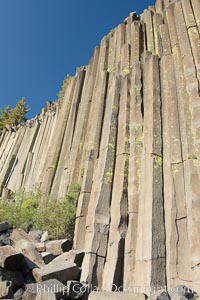
Devil's Postpile, a spectacular example of columnar basalt. Once molten and under great pressure underground, the lava that makes up Devil's Postpile cooled evenly and slowly, contracting and fracturing into polygonal-sided columns. The age of the formation is estimated between 100 and 700 thousand years old. Sometime after the basalt columns formed, a glacier passed over the formation, cutting and polishing the tops of the columns. The columns have from three to seven sides, varying because of differences in how quickly portions of the lava cooled.
Location: Devils Postpile National Monument, California
Image ID: 23285
Location: Devils Postpile National Monument, California
Image ID: 23285
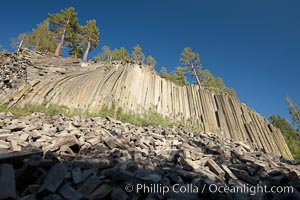
Devil's Postpile, a spectacular example of columnar basalt. Once molten and under great pressure underground, the lava that makes up Devil's Postpile cooled evenly and slowly, contracting and fracturing into polygonal-sided columns. The age of the formation is estimated between 100 and 700 thousand years old. Sometime after the basalt columns formed, a glacier passed over the formation, cutting and polishing the tops of the columns. The columns have from three to seven sides, varying because of differences in how quickly portions of the lava cooled.
Location: Devils Postpile National Monument, California
Image ID: 23281
Location: Devils Postpile National Monument, California
Image ID: 23281
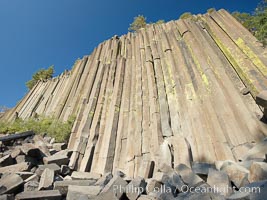
Devil's Postpile, a spectacular example of columnar basalt. Once molten and under great pressure underground, the lava that makes up Devil's Postpile cooled evenly and slowly, contracting and fracturing into polygonal-sided columns. The age of the formation is estimated between 100 and 700 thousand years old. Sometime after the basalt columns formed, a glacier passed over the formation, cutting and polishing the tops of the columns. The columns have from three to seven sides, varying because of differences in how quickly portions of the lava cooled.
Location: Devils Postpile National Monument, California
Image ID: 23282
Location: Devils Postpile National Monument, California
Image ID: 23282
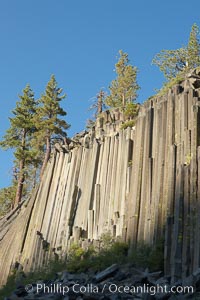
Devil's Postpile, a spectacular example of columnar basalt. Once molten and under great pressure underground, the lava that makes up Devil's Postpile cooled evenly and slowly, contracting and fracturing into polygonal-sided columns. The age of the formation is estimated between 100 and 700 thousand years old. Sometime after the basalt columns formed, a glacier passed over the formation, cutting and polishing the tops of the columns. The columns have from three to seven sides, varying because of differences in how quickly portions of the lava cooled.
Location: Devils Postpile National Monument, California
Image ID: 23283
Location: Devils Postpile National Monument, California
Image ID: 23283
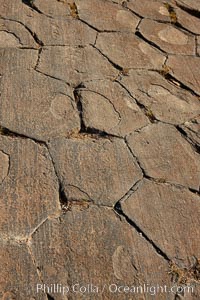
Devil's Postpile, a spectacular example of columnar basalt. Once molten and under great pressure underground, the lava that makes up Devil's Postpile cooled evenly and slowly, contracting and fracturing into polygonal-sided columns. The age of the formation is estimated between 100 and 700 thousand years old. Sometime after the basalt columns formed, a glacier passed over the formation, cutting and polishing the tops of the columns. The columns have from three to seven sides, varying because of differences in how quickly portions of the lava cooled.
Location: Devils Postpile National Monument, California
Image ID: 23284
Location: Devils Postpile National Monument, California
Image ID: 23284
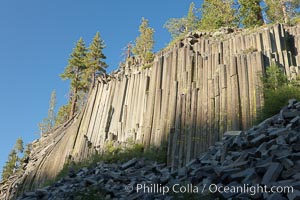
Devil's Postpile, a spectacular example of columnar basalt. Once molten and under great pressure underground, the lava that makes up Devil's Postpile cooled evenly and slowly, contracting and fracturing into polygonal-sided columns. The age of the formation is estimated between 100 and 700 thousand years old. Sometime after the basalt columns formed, a glacier passed over the formation, cutting and polishing the tops of the columns. The columns have from three to seven sides, varying because of differences in how quickly portions of the lava cooled.
Location: Devils Postpile National Monument, California
Image ID: 23286
Location: Devils Postpile National Monument, California
Image ID: 23286
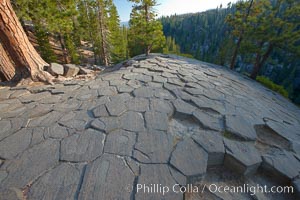
Devil's Postpile, a spectacular example of columnar basalt. Once molten and under great pressure underground, the lava that makes up Devil's Postpile cooled evenly and slowly, contracting and fracturing into polygonal-sided columns. The age of the formation is estimated between 100 and 700 thousand years old. Sometime after the basalt columns formed, a glacier passed over the formation, cutting and polishing the tops of the columns. The columns have from three to seven sides, varying because of differences in how quickly portions of the lava cooled.
Location: Devils Postpile National Monument, California
Image ID: 23287
Location: Devils Postpile National Monument, California
Image ID: 23287
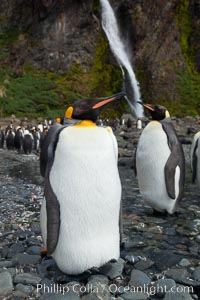
King penguins gather in a steam to molt, below a waterfall on a cobblestone beach at Hercules Bay.
Species: King penguin, Aptenodytes patagonicus
Location: Hercules Bay, South Georgia Island
Image ID: 24384
Species: King penguin, Aptenodytes patagonicus
Location: Hercules Bay, South Georgia Island
Image ID: 24384
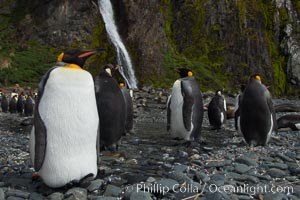
King penguins gather in a steam to molt, below a waterfall on a cobblestone beach at Hercules Bay.
Species: King penguin, Aptenodytes patagonicus
Location: Hercules Bay, South Georgia Island
Image ID: 24557
Species: King penguin, Aptenodytes patagonicus
Location: Hercules Bay, South Georgia Island
Image ID: 24557
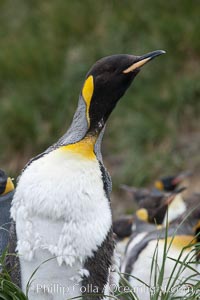
Molting king penguin.
Species: King penguin, Aptenodytes patagonicus
Location: Salisbury Plain, South Georgia Island
Image ID: 24450
Species: King penguin, Aptenodytes patagonicus
Location: Salisbury Plain, South Georgia Island
Image ID: 24450

King penguins at Salisbury Plain. Silver and black penguins are adults, while brown penguins are 'oakum boys', juveniles named for their distinctive fluffy plumage that will soon molt and taken on adult coloration.
Species: King penguin, Aptenodytes patagonicus
Location: Salisbury Plain, South Georgia Island
Image ID: 24452
Species: King penguin, Aptenodytes patagonicus
Location: Salisbury Plain, South Georgia Island
Image ID: 24452
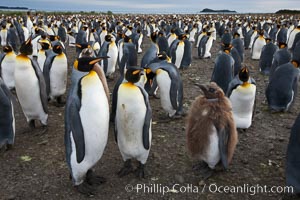
King penguins at Salisbury Plain. Silver and black penguins are adults, while brown penguins are 'oakum boys', juveniles named for their distinctive fluffy plumage that will soon molt and taken on adult coloration.
Species: King penguin, Aptenodytes patagonicus
Location: Salisbury Plain, South Georgia Island
Image ID: 24457
Species: King penguin, Aptenodytes patagonicus
Location: Salisbury Plain, South Georgia Island
Image ID: 24457
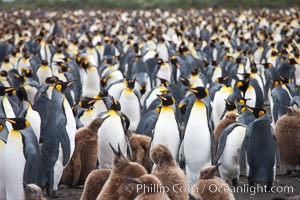
King penguins at Salisbury Plain. Silver and black penguins are adults, while brown penguins are 'oakum boys', juveniles named for their distinctive fluffy plumage that will soon molt and taken on adult coloration.
Species: King penguin, Aptenodytes patagonicus
Location: Salisbury Plain, South Georgia Island
Image ID: 24506
Species: King penguin, Aptenodytes patagonicus
Location: Salisbury Plain, South Georgia Island
Image ID: 24506
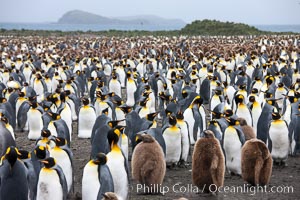
King penguins at Salisbury Plain. Silver and black penguins are adults, while brown penguins are 'oakum boys', juveniles named for their distinctive fluffy plumage that will soon molt and taken on adult coloration.
Species: King penguin, Aptenodytes patagonicus
Location: Salisbury Plain, South Georgia Island
Image ID: 24507
Species: King penguin, Aptenodytes patagonicus
Location: Salisbury Plain, South Georgia Island
Image ID: 24507
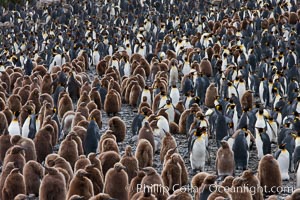
King penguins at Salisbury Plain. Silver and black penguins are adults, while brown penguins are 'oakum boys', juveniles named for their distinctive fluffy plumage that will soon molt and taken on adult coloration.
Species: King penguin, Aptenodytes patagonicus
Location: Salisbury Plain, South Georgia Island
Image ID: 24537
Species: King penguin, Aptenodytes patagonicus
Location: Salisbury Plain, South Georgia Island
Image ID: 24537

King penguins at Salisbury Plain. Silver and black penguins are adults, while brown penguins are 'oakum boys', juveniles named for their distinctive fluffy plumage that will soon molt and taken on adult coloration.
Species: King penguin, Aptenodytes patagonicus
Location: Salisbury Plain, South Georgia Island
Image ID: 24538
Species: King penguin, Aptenodytes patagonicus
Location: Salisbury Plain, South Georgia Island
Image ID: 24538
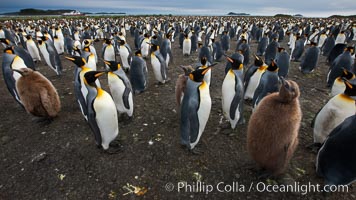
King penguins at Salisbury Plain. Silver and black penguins are adults, while brown penguins are 'oakum boys', juveniles named for their distinctive fluffy plumage that will soon molt and taken on adult coloration.
Species: King penguin, Aptenodytes patagonicus
Location: Salisbury Plain, South Georgia Island
Image ID: 24541
Species: King penguin, Aptenodytes patagonicus
Location: Salisbury Plain, South Georgia Island
Image ID: 24541
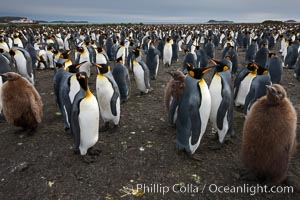
King penguins at Salisbury Plain. Silver and black penguins are adults, while brown penguins are 'oakum boys', juveniles named for their distinctive fluffy plumage that will soon molt and taken on adult coloration.
Species: King penguin, Aptenodytes patagonicus
Location: Salisbury Plain, South Georgia Island
Image ID: 24542
Species: King penguin, Aptenodytes patagonicus
Location: Salisbury Plain, South Georgia Island
Image ID: 24542
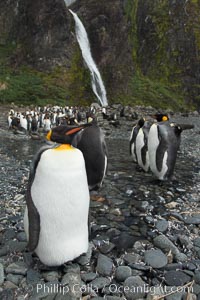
King penguins gather in a steam to molt, below a waterfall on a cobblestone beach at Hercules Bay.
Species: King penguin, Aptenodytes patagonicus
Location: Hercules Bay, South Georgia Island
Image ID: 24468
Species: King penguin, Aptenodytes patagonicus
Location: Hercules Bay, South Georgia Island
Image ID: 24468
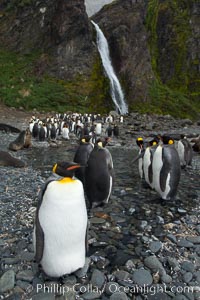
King penguins gather in a steam to molt, below a waterfall on a cobblestone beach at Hercules Bay.
Species: King penguin, Aptenodytes patagonicus
Location: Hercules Bay, South Georgia Island
Image ID: 24469
Species: King penguin, Aptenodytes patagonicus
Location: Hercules Bay, South Georgia Island
Image ID: 24469
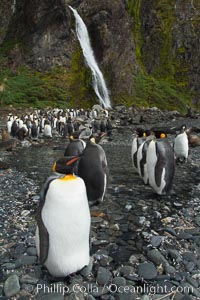
King penguins gather in a steam to molt, below a waterfall on a cobblestone beach at Hercules Bay.
Species: King penguin, Aptenodytes patagonicus
Location: Hercules Bay, South Georgia Island
Image ID: 24470
Species: King penguin, Aptenodytes patagonicus
Location: Hercules Bay, South Georgia Island
Image ID: 24470
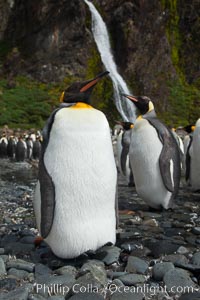
King penguins gather in a steam to molt, below a waterfall on a cobblestone beach at Hercules Bay.
Species: King penguin, Aptenodytes patagonicus
Location: Hercules Bay, South Georgia Island
Image ID: 24471
Species: King penguin, Aptenodytes patagonicus
Location: Hercules Bay, South Georgia Island
Image ID: 24471
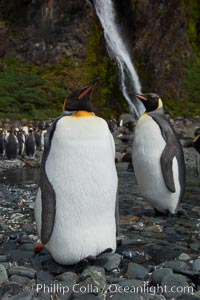
King penguins gather in a steam to molt, below a waterfall on a cobblestone beach at Hercules Bay.
Species: King penguin, Aptenodytes patagonicus
Location: Hercules Bay, South Georgia Island
Image ID: 24472
Species: King penguin, Aptenodytes patagonicus
Location: Hercules Bay, South Georgia Island
Image ID: 24472
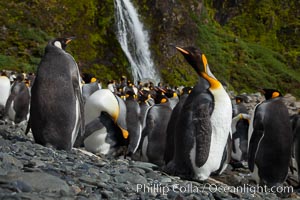
King penguins gather in a steam to molt, below a waterfall on a cobblestone beach at Hercules Bay.
Species: King penguin, Aptenodytes patagonicus
Location: Hercules Bay, South Georgia Island
Image ID: 24473
Species: King penguin, Aptenodytes patagonicus
Location: Hercules Bay, South Georgia Island
Image ID: 24473
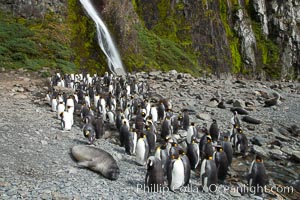
King penguins gather in a steam to molt, below a waterfall on a cobblestone beach at Hercules Bay.
Species: King penguin, Aptenodytes patagonicus
Location: Hercules Bay, South Georgia Island
Image ID: 24474
Species: King penguin, Aptenodytes patagonicus
Location: Hercules Bay, South Georgia Island
Image ID: 24474
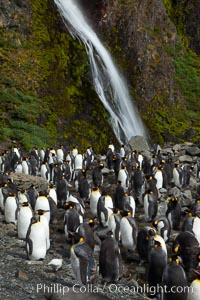
King penguins gather in a steam to molt, below a waterfall on a cobblestone beach at Hercules Bay.
Species: King penguin, Aptenodytes patagonicus
Location: Hercules Bay, South Georgia Island
Image ID: 24475
Species: King penguin, Aptenodytes patagonicus
Location: Hercules Bay, South Georgia Island
Image ID: 24475
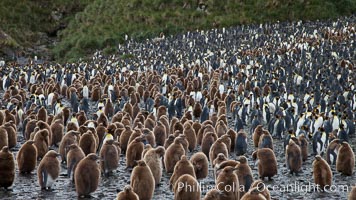
King penguins at Salisbury Plain. Silver and black penguins are adults, while brown penguins are 'oakum boys', juveniles named for their distinctive fluffy plumage that will soon molt and taken on adult coloration.
Species: King penguin, Aptenodytes patagonicus
Location: Salisbury Plain, South Georgia Island
Image ID: 24536
Species: King penguin, Aptenodytes patagonicus
Location: Salisbury Plain, South Georgia Island
Image ID: 24536
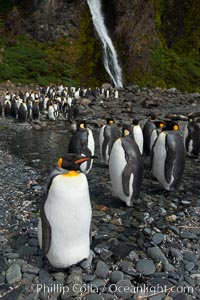
King penguins gather in a steam to molt, below a waterfall on a cobblestone beach at Hercules Bay.
Species: King penguin, Aptenodytes patagonicus
Location: Hercules Bay, South Georgia Island
Image ID: 24558
Species: King penguin, Aptenodytes patagonicus
Location: Hercules Bay, South Georgia Island
Image ID: 24558